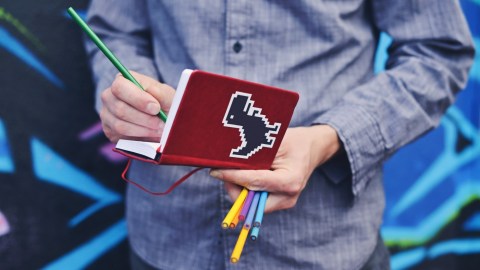To remember something, draw it

(Sticker Mule/Unsplash)
- Drawing something that you want to remember is more effective than using other memory techniques
- For older people with dementia or Alzheimer’s, drawing stores memories in still-intact regions of the brain
- Even if you’re terrible at drawing, it’s the neurological underpinnings that make it worth a try
It seems everyone wishes they had a better memory than they do. From simple herbs like ginkgo biloba to weird mnemonic systems — a friend of mine, for some unknowable reason, remembers my name with the phrase “Pig Car” — there are some out-there ideas out there. A new study from researchers at University of Waterloo (UW), however, says there’s an extremely effective and simple way to ensure you don’t forget something: Draw it.
The method may even be able to strengthen memory in the elderly who are facing the the effects of conditions such as dementia and Alzheimer’s.

(Eepeng Cheong/Unsplash
Drawing vs. writing
In the study, which was published in Experimental Aging and Research in the spring of 2017, researchers found that drawing was a more effective tool for retention than writing, re-writing, visualizations, and even looking at pictures. According to the study, led by cognitive neuroscientist Melissa E. Meade, you don’t have to actually be any good at drawing — cue the sigh of relief — it’s the the act itself that generates the benefit. “For example, drawing a picture of some groceries you need to pick up later or the meal you are planning to make will result in that information being remembered much better later on than if it were written,” Meade tells HuffPost.
Since drawing involves consideration of a thing from so many different angles — visual, spatial, semantic, and verbal — and also involves motor use, the brain stores a memory in more areas of the brain, thus solidifying it.

Photo credit: Taru Huhkio on Unsplash
You must remember this. (Not really, it’s just a song)
Meade and her collaborators, Myra Fernandes and Jeffrey Wammes, asked 48 participants to test a few memory methods. Half of the people were UW undergraduates around 20 years in age, and the rest were volunteers around 80.
Both groups were presented a series of words and asked to write each one, write out its characteristics, or draw the word.
The subjects took a break and were then asked to list all of the words they could remember from the exercise. While the younger subjects remembered more words than the older participants, both groups exhibited a better memory for words they had drawn.

Photo credit: Alex Boyd on Unsplash
Good for anyone, great for the elderly
The experiment made clear that drawing is a great way to remember things, and it’s so easily done. “Drawing improves memory across a variety of tasks and populations, and the simplicity of the strategy means that it can be used in many settings,” Fernandes told Waterloo News.
In addition, the implications for the elderly are especially exciting. Also speaking with Waterloo News Meade says, “Our findings have exciting implications for therapeutic interventions to help dementia patients hold on to valuable episodic memories throughout the progression of their disease.”
The reason for this may be that, though mainstay memory areas in the brain such as the hippocampus and frontal lobes deteriorate with age, other areas, in particular the visuospatial regions, remain intact even in patients of advanced age, and in those with dementia. “We think that drawing is particularly relevant for people with dementia,” says Meade, “because it makes better use of brain regions that are still preserved, and could help people experiencing cognitive impairment with memory function.” She adds, “We’re really encouraged by these results and are looking into ways that it can be used to help people with dementia, who experience rapid declines in memory and language function.”
It’s time to let out your inner artist. Talent not required.





